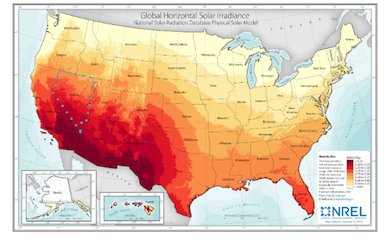Overview
The Federal Aviation Administration (FAA) recently announced a final policy to replace their interim glint and glare guidance. The update states the FAA’s final stance on how solar photovoltaic (PV) developments should be managed from a glint and glare perspective and what federally obligated airports [1] need to be doing and providing to the FAA to ensure that there are no safety concerns for a proposed PV installation. This article presents the latest changes to the FAA guidance alongside a discussion on the implications for both airports and developers in the USA and internationally, where the FAA guidance is followed.
The Final FAA Guidance Update – Summary
The final FAA policy supersedes the previous 2013 interim guidance. The 2021 update aims to give federally obligated airports more control over the decision making for developments on their airport, which previously lay with the FAA. The key points, taken from the FAA press release which summarises the guidance update and variations over the interim guidance, are presented in turn below. Quoted text is italicised.
The policy requires airports to measure the visual impact of such projects on pilots and air traffic control personnel.
- The FAA methodology has always required assessment of the Air Traffic Control (ATC) Tower and the 2-mile approach path. By now referring to ‘pilots’ only, it means that request for additional pilot receptors, such as visual circuits, could become more common. The final document itself however plays down the impact upon pilots and specifically mentions the requirement for the assessment of the ATC Tower. This is discussed further following this list. In the UK, the assessment of additional receptor has already become more common over recent years as aerodrome safeguarding officers request their preferred glint and glare methodology relative to their specific operations.
The policy applies to proposed solar energy systems at federally obligated airports with control towers.
- This means officially that only proposed on-airfield PV developments where an ATC Tower is present need to be considered. It has always been the case within the FAA guidance that only on-airfield development be assessed but over the years it has become standard practice to consider proposed developments that are within the vicinity of an aerodrome, out to several kilometres. Where a federally obligated airfield does not have an ATC Tower, officially no glint and glare assessment is now required.
As more airports invests in this technology for environmental and economic benefits, the FAA wants to make sure that the reflection from the systems’ glass surfaces do not create a glare that poses a safety hazard for pilots and air traffic controllers.
- As the solar panel’s glass surface is specifically mentioned, it could lead to more glint and glare assessments being required for other development on or near to an airfield with large glass façades. Indeed Pager Power has undertaken many assessments of reflective surfaces capable of producing specular reflections for aviation receptors, not just glass. It is possible that this point was included to accommodate changing requests for glint and glare assessment within the guidance.
Under the final policy, airports are no longer required to submit the results of an ocular analysis to FAA. Instead, the airport must file a Notice of Proposed Construction or Alteration Form 7460-1 that includes a statement that the project will not cause any visual impact. The airport submits the form to the FAA for review and approval.
- This is one of the main differences. In the USA, it is now the responsibility of the federally obligated aerodrome to ultimately make the decision on the acceptability of a proposed development. In the UK this has always been the case, with the CAA rarely commenting on individual developments. In Ireland however, the IAA are more involved. This point within the guidance varies from country to country but the change in stance from the FAA in the USA is nothing new internationally.
The FAA relies on the airport to confirm via the form that it has sufficiently analysed the potential for glint and glare and determined there is no potential for ocular impact to the airport traffic control tower cab. If any impacts are discovered after construction, the airport must mitigate the impact at its expense. The airport may also face compliance action for failure to address visual impacts that create aviation safety hazards. As such, the agency encourages an airport to conduct sufficient analysis before installing a solar energy system.
- Retrospective requirements for mitigation were not explicitly stated within the previous versions of the guidance. It could be taken from the above that any decision to assess glint and glare in different ways should be considered against the risk of requiring retrospective mitigation if effects have not been adequately identified. Retrospective mitigation will always be more expensive and time-consuming than planning any mitigation requirement within the original design. Indeed it was a development in the USA where retrospective mitigation was required, and it is this development where it is believed that the requirement for glint and glare assessments originated. This development at Manchester Airport, Boston, is discussed in this previous article.
The FAA is also withdrawing the recommended tool for measuring the ocular impact of potential glint and glare effects on pilots and air traffic controllers.
- This could be considered the most significant change within the final FAA guidance for glint and glare. The FAA had previously worked with Sandia National Laboratories to develop the Solar Glare Hazard Analysis Tool (SGHAT) which has since been re-developed under Forge. The FAA previously stated that all assessments needed to be completed using the Sandia methodology; however, the FAA no longer recommend any single methodology for glint and glare modelling and this could open up alternative options and methodologies. Pager Power guidance has always recommended consideration of the operational requirements of an aerodrome and analysis of the real-world scenarios in which glare effects may occur before providing an overall conclusion. The FAA guidance is very black and white on what is acceptable which, in this author’s opinion, can be too restrictive in reality. Hopefully this change will lead to a more open and pragmatic approach.
A key section of text taken from the specific guidance update is presented below:
Initially, FAA believed that solar energy systems could introduce a novel glint and glare effect to pilots on final approach. FAA has subsequently concluded that in most cases, the glint and glare from solar energy systems to pilots on final approach is similar to glint and glare pilots routinely experience from water bodies, glass-façade buildings, parking lots, and similar features. However, FAA has continued to receive reports of potential glint and glare from on-airport solar energy systems on personnel working in ATCT cabs. Therefore, FAA has determined the scope of agency policy should be focused on the impact of on-airport solar energy systems to federally-obligated towered airports, specifically the airport’s ATCT cab.
The policy in this document updates and replaces the previous policy by encouraging airport sponsors to conduct an ocular analysis of potential impacts to ATCT cabs prior to submittal of a Notice of Proposed Construction or Alteration Form 7460-1 (hereinafter Form 7460-1). Airport sponsors are no longer required to submit the results of an ocular analysis to FAA. Instead, to demonstrate compliance with 14 CFR 77.5(c), FAA will rely on the submittal of Form 7460-1 in which the sponsor confirms that it has analyzed the potential for glint and glare and determined there is no potential for ocular impact to the airport’s ATCT cab. This process will enable FAA to evaluate the solar energy system project, with assurance that the system will not impact the ATCT cab.
The above implies that the risk of glare towards a pilot is no longer a consideration, however it is unlikely that any airfield safeguarding officer would sign off a solar PV development without consideration of at least the 2-mile approach path. The FAA has now put the onus on the airfield operator to make appropriate decisions for their aerodrome, and it is unlikely that a relaxation of the previous interim guidance would now take place.
There appears to be some ambiguity between the FAA announcement and the guidance itself. The implications are discussed in the following section.
The full FAA announcement can be found here.
The updated FAA guidance document can be found here.
The Final FAA Guidance Update – Discussion
So what does the update mean to aerodromes who tend to follow the FAA guidance, and developers who build on or near airports both in the USA and internationally?
In reality, probably not a lot, at least to begin with. However for proposed developments in the USA, it is now the responsibility of the federally obligated airport to sign off on the glint and glare assessment and not the FAA.
The FAA not endorsing a singular provider of modelling may also invite alternative methodologies. Again, in reality, airports will likely stick to what they know, using familiar modelling techniques and taking advice from familiar experts in this area.
The change may lead to a more pragmatic approach being considered by some stakeholders who undertake or review the reports from experts. This is because specific glare requirements are not listed for specific receptors i.e. pilots. It may lead to more airport/aerodrome specific receptors being requested for assessment as safeguarding officers seek to have their aerodrome-specific operations considered within the assessment. It is unlikely to lead to a relaxation in the assessment criteria for pilots.
It remains to be seen how this will affect glint and glare assessment methodologies going forward as this change is very new. Pager Power will consider this update within an update to its Glint and Glare Guidance Document (currently in its third edition), however significant variation are not expected.
Conclusions
The FAA’s final guidance document closes off the interim guidance and offers more control to the aerodrome in dictating how assessments are done, as well as opening the doors to new ways of assessing glare and aviation. The ATC Tower is still a specific assessment requirement for operators of federally obligated airports. The assessment for pilots is now not specifically referenced. The guidance change will likely make little difference to how assessments are completed, but it does mean that there is no longer a single assessment process endorsed by the FAA. The airfield operator will however need to make a careful and considered decision on how solar PV developments proposed on their airfield should be assessed. Whilst the guidance states it is only applicable to on-airfield developments, it is expected that airfield operators will continue to request glint and glare assessment for off-airfield developments to ensure the rigorous safety standards are maintained, especially now the decision to sign-off the development is down to them.
Pager Power will be updating its advice, guidance document and technical reports going forwards based on this new release from the FAA. An update to the guidance will be issued in the near future, and an update within our technical reports will begin to roll out in the coming weeks.
References
[1] Federally obligated airports are public airports that have accepted federal assistance either in the form of grants or property conveyances.
Thumbnail image accreditation: Chelsea (May 2019) from Unsplash.com. Last accesses March 2022. Available at: https://unsplash.com/photos/WvusC5M-TM8



